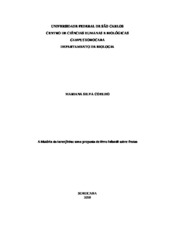Mostrar el registro sencillo del ítem
A história da laranjinha: uma proposta de livro infantil sobre frutas
| dc.contributor.author | Coelho, Mariana Silva | |
| dc.date.accessioned | 2020-08-18T01:10:50Z | |
| dc.date.available | 2020-08-18T01:10:50Z | |
| dc.date.issued | 2020-07-14 | |
| dc.identifier.citation | COELHO, Mariana Silva. A história da laranjinha: uma proposta de livro infantil sobre frutas. 2020. Trabalho de Conclusão de Curso (Graduação em Ciências Biológicas) – Universidade Federal de São Carlos, Sorocaba, 2020. Disponível em: https://repositorio.ufscar.br/handle/ufscar/13164. | * |
| dc.identifier.uri | https://repositorio.ufscar.br/handle/ufscar/13164 | |
| dc.description.abstract | Botany is an area of science that started very early in human history. It developed over the early centuries, but in the last few decades it holds one of the most boring methods of teaching Education. This scenario makes the socialization process between human beings and plants something basically impractical outside the classroom, which makes the process of assimilation and appreciation of the presence of vegetables in people's daily lives very difficult, which we call Plant Blindness. In Basic Education, the situation of Botany is not favorable given that there are almost no mentions of plants in the National Common Base Curriculum for this phase. Therefore, we thought of a proposal to bridge the gap between the teaching of Botany and Early Childhood Education, in the form of a children's story book, entitled “The story of the little orange”. The book was produced to help the teacher to start introducing the subject in a more playful way for children of 3 to 4 years-old. Therefore, this material was designed with the hope that it will contribute to the future of these children and the plants that surrounds us. The main objective was arousing children's curiosity for the plants that surround them and acting in scientific dissemination. The story was told to some students at a Childhood Education Center in the city of Sorocaba, in the state of São Paulo. With the results obtained, we were able to confirm that there are many gaps between the teaching of Botany and Early Childhood Education. | eng |
| dc.description.sponsorship | Não recebi financiamento | por |
| dc.language.iso | por | por |
| dc.publisher | Universidade Federal de São Carlos | por |
| dc.rights | Attribution-NonCommercial-NoDerivs 3.0 Brazil | * |
| dc.rights.uri | http://creativecommons.org/licenses/by-nc-nd/3.0/br/ | * |
| dc.subject | Cegueira botânica | por |
| dc.subject | Educação infantil | por |
| dc.subject | Livro infantil | por |
| dc.subject | Contação de história | por |
| dc.subject | Material didático | por |
| dc.subject | Divulgação científica | por |
| dc.subject | Desenvolvimento e morfologia | por |
| dc.title | A história da laranjinha: uma proposta de livro infantil sobre frutas | por |
| dc.title.alternative | The story of the little orange: a children's book proposal about fruits | eng |
| dc.type | TCC | por |
| dc.contributor.advisor1 | Souto, Leticia Silva | |
| dc.contributor.advisor1Lattes | http://lattes.cnpq.br/9284280370140756 | por |
| dc.description.resumo | A Botânica é uma área da ciência que se iniciou muito precocemente na história da humanidade. Ela se desenvolveu ao longo dos séculos seguintes, porém nas últimas décadas detém um dos métodos mais enfadonhos de ensino da Educação. Esse cenário torna o processo de socialização entre o ser humano e os vegetais algo basicamente impraticável fora das salas de aula o que dificulta, e muito, o processo de assimilação e valorização da presença dos vegetais no cotidiano das pessoas, o que chamamos de Cegueira Botânica. Na Educação Básica, a situação da Botânica não é favorável dado que quase não há menções de plantas na Base Nacional Comum Curricular para essa fase Por isso, pensamos em uma proposta para diminuir a lacuna entre o ensino de Botânica e a Educação Infantil, na forma de um livro de história infantil, intitulado “A História da Laranjinha”. O livro foi produzido para auxiliar o professor a iniciar a introdução do assunto de uma maneira mais lúdica e que mais se aproxima da realidade das crianças de 3 a 4 anos. Assim sendo, este material foi pensado com a esperança de que isso contribua para o futuro dessas crianças e da flora que nos rodeia, tendo o principal objetivo despertar a curiosidade das crianças para os vegetais que a cercam e atuar na divulgação científica. A história foi contada para alguns alunos de um Centro de Educação Infantil da cidade de Sorocaba, interior do estado de São Paulo. Com os resultados obtidos, pudemos confirmar que existem muitos vácuos entre o ensino de Botânica e a Educação Infantil. | por |
| dc.publisher.initials | UFSCar | por |
| dc.subject.cnpq | CIENCIAS HUMANAS::EDUCACAO::ENSINO-APRENDIZAGEM | por |
| dc.publisher.address | Câmpus Sorocaba | por |
| dc.contributor.authorlattes | http://lattes.cnpq.br/6962595274227565 | por |
| dc.publisher.course | Ciências Biológicas - CBLN-So | por |

